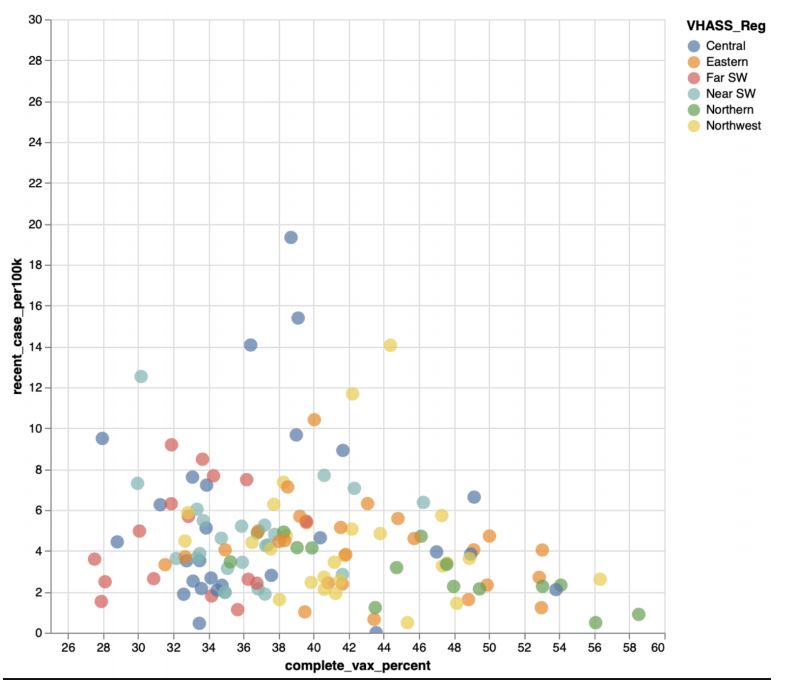
Correlation between COVID-19 case rate and percentage of population vaccinated in Virginia localities. Source: “Analysis of COVID-19 in Virginia July 21th, 2021.
by James A. Bacon
There has been a lot of discussion about the causes of vaccine hesitancy: Trump-voting evangelicals are idiots, Blacks are still scarred by the Tuskegee syphilis experiments, social media is spewing disinformation, people have lost faith in the “experts,” etc. Here’s a clue: People are most influenced by their interactions with the people around them.
The graph above, compiled by the Virginia Biocomplexity Institute (VBI), shows the correlation between the incidence of COVID-19 in a locality around July 20 and the percentage of the population that had been vaccinated. In its latest update, VBI observes that there is “some” correlation between vaccination rates and the rate of spread. But if you eyeball the graph, you can see that the correlation is a weak one.
In fact, I’d go a step further. For localities with a vaccination rate of 44% or lower, the correlation appears to be non-existent. Only when the vaccination rate hits 45% to 46% does a high rate of vaccinations in Virginia seem to be associated with a lower rate of transmission. (With the spread of the Delta variant, the dynamics might change. More up-to-date figures might tell a different story.)
VBI publishes other graphs based upon polling data. The survey asks respondents how likely they are to get vaccinated, and asks them to describe their reasons for hesitancy. Summarizes the report:
- Top reasons for hesitancy: side effects, distrust (increasing),
unnecessary (increasing) - More likely to take if recommended by: doctors and friends
- Reasons unnecessary: Not serious, not high risk, or other
VBI also breaks down trend lines for vaccine hesitancy (red and orange) by six geographic regions.
Remarkably, vaccine hesitancy since April 2021 has increased in Northern, Central, and Eastern Virginia, which encompass Virginia’s three largest metropolitan areas. Hesitancy is not just a rural phenomenon.
Distrust. It would be interesting to find out why mistrust is increasing in the face of steady government messaging, media messaging, and social media censorship in favor of vaccinations. I would speculate that distrust in government institutions and the media have engendered massive skepticism about the willingness of those institutions to honestly interpret and act upon the “science.” I’m not saying the skepticism is justified — just that it exists. This reasoning should be seen in light of the larger rebellion against the “elites” and “experts” that Bacon’s Rebellion has been exploring in recent posts.
Unnecessary. Another other major factor cited is the belief that vaccinations are unnecessary. VBI should probe deeper. There are different rationales for saying vaccinations are unnecessary. One is that 700,000 or more Virginians have been exposed to COVID-19 and, as a result, have acquired natural resistance. How strong that resistance is compared to the vaccines and how long it will last are open scientific questions. But if you have survived the virus, it is reasonable to think you have added resistance.
Another explanation is that some Virginians are free-riding on the vaccinations of others. If half the population is vaccinated and other 20% are survivors, their thinking might go, we’re getting close to herd immunity. Why should I bother then?
Low risk. Finally, many Virginians — particularly young, healthy ones — perceive themselves as low risks for hospitalization even if they catch the virus. Again, they might calculate, why bother?
Circling back to the graph atop this post, we might suggest that many Virginians live in localities (44% or lower vaccination rates) where they see no correlation between vaccination levels and the incidence of the disease — because there is no correlation. But the evidence looks strong that localities that exceed the 44% vaccination rate do experience lower COVID spread. From a public health perspective, if we get those vaccination rates higher, the spread slows and everyone benefits.
The trick is persuading the hard-core anti-vaxxers. We will not do it by telling them they are stupid, ignorant and selfish. We have to appeal to their self-interest. The VPI survey data says that people trust their doctors and friends. If we somehow manage to convert the anti-vaxxers, that’s how we reach them.



